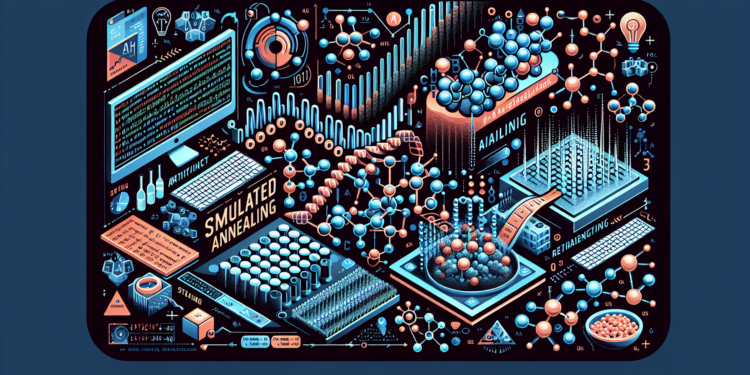Simulated Annealing (SA), or Simulated Annealing, is a proven metaheuristic for optimizing complex global problems that is inspired by the physical process of heating and then slowly cooling a material to increase the size of its crystals and reduce its defects. The name originates from metallurgy: “annealing” is a thermal process that alters the physical properties of a material to increase its ductility and decrease its hardness. This technique is commonly used in artificial intelligence to find approximations to optimal solutions in cases where handling large search spaces is required and other methods like exhaustive search would be unfeasible.
Theoretical Foundations of Simulated Annealing
The Simulated Annealing algorithm was proposed initially by Scott Kirkpatrick, C. Daniel Gelatt, and Mario P. Vecchi in 1983. Its theoretical foundation is based on statistical mechanics, particularly on the Metropolis algorithm, which was developed for the simulation of the evolution of the states of particle systems. In the optimization context, SA is interpreted as a search process where the space of possible solutions is explored—often in a stochastic manner—to escape local optima and gradually converge towards a globally optimal or acceptably suboptimal solution.
The process begins with the generation of a random solution to the problem and a high initial “temperature.” Temperature is a metaphorical variable that controls the probability of accepting solutions worse than the current one, which allows for exploration beyond local optima. As the temperature decreases, the algorithm becomes more conservative, accepting fewer worse solutions and refining towards an optimum.
Emerging Practical Applications
SA has found use in a variety of fields due to its versatility in optimization problems, including:
- Integrated Circuit Design: for component placement and wire routing configuration.
- Aerodynamics: optimization of wing and fuselage shapes to improve fuel efficiency and aerodynamic performance.
- Operations Research: as in route planning for efficiency in logistics and product delivery.
- Bioinformatics: for protein folding and DNA sequence assembly.
- Machine Learning: for model selection techniques and hyperparameter tuning.
Furthermore, with advancements in computing and the potential for greater computational power, combinations of SA with other heuristic approaches and artificial intelligence algorithms, such as GA (Genetic Algorithms) or ACO (Ant Colony Optimization), have been explored to create more robust and efficient hybrid systems.
Analysis and Comparisons
In the literature, innumerable case studies and comparisons of SA with other optimization methods can be found. For instance, the efficacy of SA in comparison to deterministic algorithms, such as gradient descent, is often mentioned in the context of SA’s ability to avoid getting stuck in local optima. On the other hand, it has the advantage of being conceptually simpler and less restrictive in terms of the differentiability requirements of the objective functions compared to gradient-based methods.
However, SA also has its disadvantages, such as a higher computational load and the challenge of adjusting parameters like the initial temperature, cooling rate, and stopping criterion. These parameters can significantly affect the algorithm’s performance and require careful balancing between exploring the search space and exploiting current solutions.
Future Projections and Potential Innovations
Looking forward, it is likely that we will see more applications of SA enhanced by the advancement of adaptive algorithms and the application of machine learning techniques to dynamically adjust its parameters. Combining SA with population-based methods could also thrive, providing more robust outcomes across a broader spectrum of problems.
Researchers are also focusing on how SA can be integrated with emerging technologies, such as quantum computing, which promises to revolutionize optimization by offering new paradigms for more efficiently exploring solution spaces.
In summary, while Simulated Annealing is not a new technology in the field of artificial intelligence, its applicability continues to expand. The ability to adapt ancient principles of physics to complex decision-making problems underscores the intrigue and range of artificial intelligence as a field of study. As we continue to face increasingly complex problems, techniques like SA will be valuable tools in the arsenals of researchers and practitioners.
Experts agree that despite technological advances, Simulated Annealing will remain relevant because of its uniqueness in overcoming the limitations of other optimization strategies, its robustness, and its wide applicability. It will continue to develop and refine, possibly in symbiosis with other algorithms, to address the most demanding optimization challenges of tomorrow. The new generations of researchers and scientists will have the challenge of exploring and expanding the scope of this algorithm with zest and creativity.






















